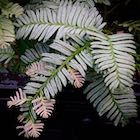Acmopyle sahniana
Buchholz et Gray 1947
Common names
Fijian acmopyle, drautabua [Fijian].
Taxonomic notes
Collected as early as 1877 and identified as early as 1920, this species was not formally described until 1947 (Buchholz and Gray 1947). See Acmopyle for further discussion. Type: Fiji, Viti Levu, Namosi, Mt. Vakarongasiu, elev. 900 m, on an exposed ridge, 1927.10.02, John W. Gillespie 3273.
Description
Monoecious evergreen trees to 12 m tall and 20 cm dbh, usually with a single erect trunk; sparsely branched, primary branches mostly emerging at angles of 40-60°r;. Bark thin, mostly smooth, sometimes pustulate, brown weathering grey; inner bark red and more or less fibrous. Foliage branches round with very small spreading leaf apices terminating spirally arranged, decurrent scale leaves; ultimate foliage branchlets 2-6 cm long, alternating, mostly plagiotropic, deciduous after a few years, with short scale leaves at base. Foliage leaves similar regardless of tree age, alternate, pectinate at 60-90°, straight or more often falcate towards apex, or weakly S-curved; in the middle of branchlets 10-25 × 2-4 mm, smaller towards proximal and distal end of branchlets, twisted and decurrent at base, margins revolute, apex acute, curved forward; midrib narrow above, often faint, but prominent below; leaves lustrous dark green above, with two whitish stomatal bands separated by a green midrib below. Stomata on both surfaces, in numerous intermittent lines, some on the midrib on the lower (abaxial) side and a few stomata near the base or apex on the upper side. Pollen cones subterminal or terminal on lateral foliage shoots, solitary or in pairs, sessile or on very short peduncles, initially globose, elongating to 5-8 × 1.5 mm; microsporophylls imbricate, carinate, acute, speading, with two basal, small pollen sacs. Seed cones subterminal or terminal on lateral foliage shoots, sometimes axillary to scale leaves or foliage leaves, solitary, on curved, scale-leaved peduncles up to 6 mm long; composed of 2-3 sterile and 1(-2) fertile amalgamated bracts, forming a fleshy, swollen, irregularly shaped, verrucose and green or purple receptacle 7-9 mm diameter. Seeds solitary at the distal end of the receptacle, ovoid, 7-9 × 5-6 mm including the epimatium, striated and greyish violet with whitish bloom when ripe (Bush and Doyle 1997, Farjon 2010).
Distribution and Ecology
Fiji: Mount Vakarogasiu, at elevations of 600 to 1050 m. Mean annual temperature is 22.3°C, with an average minimum in the coldest month of 17.5°C, and a mean annual precipitation of 2820 mm (Biffin et al. 2011, Table S5). Occurs in low rainforest on mountain ridges and summits ()Farjon 2010).
The IUCN reports that this taxon is critically endangered. The total species population is estimated to number less than 100 mature individuals. The species is currently known from localities in Namosi and near Mt Tomanivi. It was also known from the Koroyanitu Range in western Viti Levu (Mba Province) but recent (1997) searches have failed to find it there. The other subpopulations are threatened by mining. The extent of occurrence is 90 km2 if the Koroyanitu subpopulation is extinct. The area of occupancy is likely to be more than 10 km2. Subpopulations are likely to be severely fragmented and undergoing continuing decline. A. sahniana is listed under Schedule 1 of Fiji's Endangered Species Act and some subpopulations are within an area that has been identified as a priority forest for conservation, but as yet has no formal protection (Thomas 2013).
Zone 10 (cold hardiness limit between -1°C and +4.4°C) (Bannister and Neuner 2001).
Remarkable Specimens
No data as of 2023.02.21.
Ethnobotany
No specific uses have been recorded (Thomas 2013).
Observations
No data as of 2023.02.21.
Remarks
Although not described until 1947, it was recognized and discussed by Indian botanist Dr. Birbal Sahni in his 1920 treatise on Acmopyle (Phil. Trans. Roy. Soc. London B 210:253-310), and the epithet honors his work. Sahni was describing an 1877-1878 collection by J. Horne that he found in the Kew herbarium.
Citations
Buchholz, John T. and Netta E. Gray. 1947. A Fijian Acmopyle. Journal of the Arnold Arboretum 28(1):141-143.
Bush, E. W., and M. F. Doyle. 1997. Taxonomic description of Acmopyle sahniana (Podocarpaceae): additions, revisions, discussion. Harvard Papers in Botany 2(2):229-233.
Thomas, P. 2013. Acmopyle sahniana. The IUCN Red List of Threatened Species 2013: e.T31052A2801815. https://dx.doi.org/10.2305/IUCN.UK.2013-1.RLTS.T31052A2801815.en, accessed 2020.02.07.
See also
The species account at Threatened Conifers of the World.
Doyle, M. 1998. Gymnosperms of the southwest Pacific 1. Fiji. Endemic and Indigeneous Species. Changes in Nomenclature, key, annotated checklist and discussion. Harvard Papers in Botany 3(1): 101-107.
Fiji Department of the Environment. 1999. Biodiversity strategy and action plan. Suva: Department of the Environment.
NatureFiji. 2020. Acmopyle sahniana: Drautabua. https://naturefiji.org/drautabua-acmopyle-sahniana/, accessed 2020.02.07.
Olson, D., Farley, L., Patrick, A., Watling, D., Tuiwawa, M., Masibalavu, V., Lenoa, L., Bogiva, A., Qauqau, I., Atherton, J., Caginitoba, A., Tokota’a, M., Prasad, P., Naisilisil, W., Raikabula, A., Mailautoka, K., Morley, C. and Allnutt, T. 2009. Priority Forests for Conservation in Fiji: landscapes, hotspots and ecological processes. Oryx 44(1):57-70.
Smith, A.C. 1948. An ascent of Koroyanitu. Proceedings of the National Academy of Sciences 34(12):579-585.




